Experienced heavy tank A39 TORTOISE (UK)
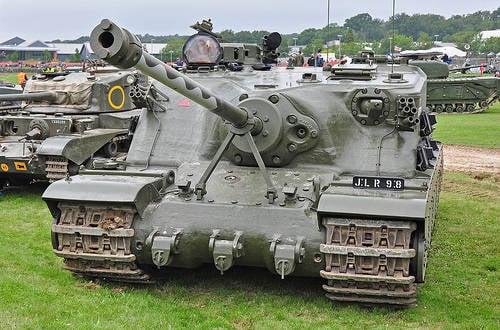
A39 Tortoise heavy assault tank is a British super-heavy assault tank designed, built and tested during World War II, but never put into serial production. The machine was designed to solve the problems of destroying heavily fortified areas, so in its design mobility was sacrificed for firepower and security. Despite the fact that this machine is called a tankIts tower is not rotary - which, combined with powerful artillery weapons and low mobility, allows it to be ranked as a super-heavy self-propelled artillery mount.
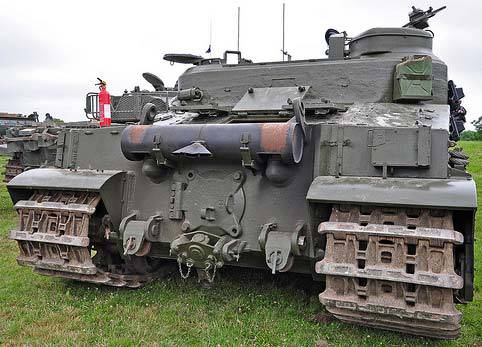
In 1942, the British General Staff, responsible for developing the concept for the development of armored vehicles, showed an interest in the so-called "assault tank" - a heavy armored vehicle capable of acting upon the breakthrough of fortifications and capable of withstanding a large number of direct hits. As a result, several experimental machines appeared, including the A33 Excelsior, the A38 Valiant and the American T14, besides there were a large number of projects that did not go further than the drawing boards. Among them was a project prepared by Newffield Mekanization Ltd., from Bermingham, which was an AT1 (Assault Tank) with 150-mm armor and a small, pear-shaped tower under the 75-mm cannon or 95-mm howitzer. The body was similar to that of “Valiant”, and the suspension was planned to be torsion. Weight was estimated at 45 t. There were two versions of this project: one similar to a tank, but with a fixed turret; the second is a more squat machine with 200-mm armor and with weapons only from a pair of machine guns. But these projects did not suit the general staff, who demanded that a six-inch mortar and a flamethrower be mounted on the roof of the hull of the right fiddle shelf.
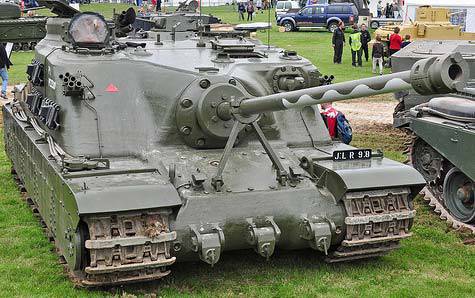
31 May 1943 G has a new project with an extended body hanging over the tracks. The level of protection remained the same, and the armament changed, making two twin machine-gun installations in turrets on the roof, 20-mm cannons on the left of the frontal sheet and six-pounds on the right with the Molins automatic loader modeled on the 3,7-inch anti-aircraft gun. After several reworkings of this project, 26 Jun 1943 g appeared AT10. This version had a six-pounder, paired with a machine gun - on the right, and an 20-mm cannon, also with a "Bose" - on the left. On the roof of the hull, behind the commander's turret was a twin machine-gun unit, designed for good back fire angles. The maximum armor thickness has now reached 225 mm, the weight was estimated at 45 t, the height of the body was 2,28 m. Newffield mecanizacion ltd considered this combination of protection and armament sufficient and began to produce a full-scale wooden layout. However, the general staff demanded that the company put on the "Tortoise" ("Turtle") - so now called the project - 75-mm cannon with a high initial velocity of the projectile.
On Newffield, it was calculated that the necessary lengthening of the hull would lead to an increase in weight to 65 t, nevertheless, Sir Miles Thomas from the management of Newffield concluded that it would not be difficult to install a new 17-pound cannon on a tank. The new project AT13 appeared 13 August 1943 r and already looked like the "Turtle" to which we are accustomed. But even after that, the gun was shifted to the right, and the 20-mm machine gun - to the left, although the 95-mm howitzer was planned instead of it. The suspension was a series of two-wheeled carts with an 32-inch caterpillar. Couples carts slightly overlap each other. The outer wheels of the carts on each side could be dismantled along with the tracked screen, which allowed the tank to pass in width across the Bailey Bridge. This resembled a similar operation with the Tigr when it was transported by rail, and on the American giant T28, the Turtle Cousin, the issue was solved even more radically — an external pair of caterpillars was dismantled there.
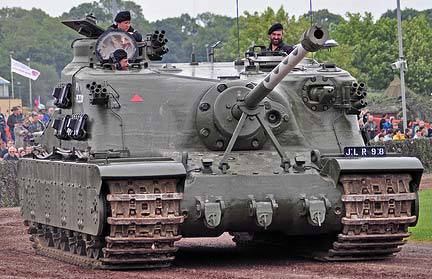
At the same time the issue was resolved with the propulsion system. For AT10, the Ford engine was planned, but it was not yet clear which V8 GAA or V12 series was. On AT13, it was decided to put a Rolls Royce Meteor with a Merritt Brown transmission. The project had one “detail” that could totally surpass all the other technical problems - the designers of Newffield planned the whole-cast Tortoises building. Although this represented undoubted benefits in terms of body ballistics, doubts arose as to the ability of the plant to process such a “part”. This was a major problem, but Miles foresaw other difficulties: would the Turtle be too heavy for existing transporters? By December, 1943 g was almost ready for the layout of the project AT13, although the last three times slightly changed. So, on AT14, instead of 20-mm cannon and machine gun, only one machine gun was installed on the left - the weight was reduced to 60 t. The AT15 gun was shifted to the center of the hull, and on AT15A the hull was increased, which brought the weight to 65 t.
At this stage, the general headquarters again intervened, which demanded the installation of a new cannon to replace the 17-pound. The model was remade for a new 37-pound gun, which was an anti-tank gun based on a proven 3,7-inch anti-aircraft gun. After the decision was made, the project was redesigned as AT16 and a prototype of non-armored steel was ordered. In February, 1944 g followed the next step - it was decided to order 25 tanks, which the general staff gave the designation A39 Tortoise, without waiting for even a prototype. This trick, tried earlier in Churchill, led to a sad result. Even at this stage of the work, it was clear that deliveries could not begin until September of 1945 r - an estimate that should have been brought to life. In the meantime, two more projects were prepared - AT17 and AT18. Both used the same chassis and differed flamethrower installed in place of the gun. Virtually the entire combat compartment was occupied by four 610-M incendiary tanks, between which there were seven high-pressure cylinders that ensured the release of fire mixture.
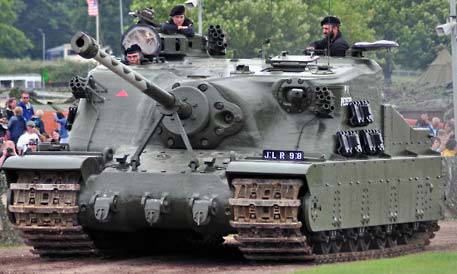
On AT17, one flamethrower was in place of the gun, and the other in the machine gun turret on the roof of the wheelhouse. AT18 had a flamethrower instead of a gun, with the frontal machine gun removed. Both projects did not go further drawings. In November, 1944 appeared another "competitor" - SP4. It was a tank with a tower installation 3,7-inch gun on the chassis A41 ("Centurion"), which was implemented only in a wooden layout. By that time, it turned out that the characteristics of the gun can be improved by replacing the 37-pound projectile with the 32-pound projectile. It was claimed that with it the characteristics of the gun were beaten on the whole on 25 above, it was on the 17-pound gun. With the end of the war in Europe, interest in A39 Tortoise began to decline rapidly. Already plans were being made for a new generation of combat vehicles, among which A39 looked like a dinosaur. The order has been reduced to 12 machines. In February, the 1946 of the Defense Committee decided to halve the order again, already to 6 machines at a price of 141666 pounds each. In reality, five tanks were completed, and parts of the sixth were used for spare parts.
The A39 Tortoise hull was welded from cast parts and rolled armor sheets. The largest casting was a cabin without a roof with a thickness of the frontal part up to 230 mm. The roof was a rolled sheet. Another molded part in the frontal part protected the transmission. The engine compartment was welded from rolled sheets of armor and hung over the tracks. In the right shelf there was a laying of the 3IPA, in the left - the charging unit and batteries. The lower part of the hull was made of rolled sheets of armor, with additional protection in the form of heavy side screens. The suspension was torsional, although it looked like a Sherman chassis. Each wheeled cart (four on board) had two pairs of rollers. Torsions were grouped under the floor of the cabin by four, so that for each side truck there were two torsions.
In most cases, the roller cart has one axle and its wheels move in a vertical plane at the same time, but on the Turtle each roller of the cart also had an independent suspension. This was provided at the design stage at the same time with the possibility of removing the outer pair of rollers of the trolley, to reduce the dimensions of the tanks during transportation, but at the same time this suspension reduced the lateral load on the trolley characteristic of the chassis with wide tracks. It should be noted that there was no provision for any dismantling of other equipment that would reduce the weight and size during transportation. What they wanted, they got it - the possibility of transportation by rail, loading through the ramp of amphibious vessels and movement on flooded bridges had to be discarded. The tracks of the caterpillar were molded of margon steel and had a centering ridge. The width of the tracks was 32 inches, each link was connected by two pins to meet each other.
Tank A39 Tortoise was a rather rare among British tanks scheme with the front leading "asterisk" in the rear engine. Sloths were respectively behind. The caterpillar had six supporting rollers on the side - two on two central shafts and one on the front and rear. The propulsion system consisted of a Rolls Royce Mk.V Meteor aspirated engine - 12-cylinder, V-shaped, HP 650 with power. Two fuel tanks were placed on the sides of the engine - a big one on the right 390 l and a small one on the left 245 l. On the left was also the oil tank, which occupied the remaining space. The radiators were in front of the engine, and the exhaust pipes were collected in a large muffler that ran along the entire engine compartment.
As mentioned above, the A39 Tortoise tank also carried a Morris-8 four-cylinder charging unit that was powered directly by a generator. The engine was included in the cooling circuit of the main engine, and the exhaust pipe with a silencer was removed behind the conning tower. The engine was driven by a gearbox through a Board & Beck clutch and three shafts united in a common tube. The gearbox was a Merritt Brown H51D, providing six forward and reverse speeds via split reverse and having onboard brakes for course control. This gearbox allowed the tank to turn in place. After testing the prototype P1, changes were made to the transmission, but which ones are not known.
One of the most interesting features of this tank - the A39 Tortoise was then considered a tank, albeit a very specific, but not self-propelled one - was a combat compartment that housed a crew of seven. The crew included the driver, who occupied the place to the right of the gun, the arrow of the frontal machine gun - to the left of the gun, another shooter was behind the driver, the commander was sitting to the left - behind and above the first gunner. Thus, four crew members were located on the sides of the cabin, making room in the center for artillery crews. The gunner of the gun was located to the left of the gun, and two loaders - behind the gun. There was an interesting problem with the latter. The gun was designed for separately loading projectiles and charges were stored separately. A small number of "finished" shells were stored on the back of the conning tower in separate canisters, and most of the ammunition was located under the floor of the crew compartment.
The problem was: should the loaders separately send the projectile and the charge case into the gun, or did one of them have to load the gun and the other only have to operate the lock? The latter was the standard practice of English gunners, but careful timing showed that the first loading scheme adopted on the Turtle is more preferable. History The creation of a 32-pound (3,7-inch - 94-mm) implement is already mentioned. You can still add; that the initial velocity of the projectile was 880 m / s, and the ammunition included armor-piercing and high-explosive shells. The gun was mounted in an 24 inch diameter ball bearing providing + 18 ° -10 °. declination and 20 degrees horizontally in both directions. The gunner's sight was mounted in a separate ball mount to the left of the gun, but was tightly connected to the gun itself.
The front shooter had at his disposal a 7,92-mm Bes machinegun, also in a small ball mount with declination angles of 35 °. Two more "Demon" were in the upper turret with a circular shelling. They had declination angles of + 15-10 °. The need for a last machine gun installation was questionable, at the same time it represented a certain danger to the radio antenna and the compass, which were mounted on the roof of the hull, not to mention the crew members. Since the entire felling roof became a “zone of fire”, the machine gun sparks were equipped with a special device that prevented the destruction of equipment on the roof of the hull. In addition, each hatch was equipped with a special switch that blocks machine-gun fire when the hatch is open. The descent of machine guns for this reason was made electric. Machine gun control (in the vertical plane) was carried out using a knob with two electric trigger buttons. For this installation, specially trained arrows were required, and not only for security reasons, the usual training did not help to eliminate the “Bes” delay in such a constrained installation. The commander also had at his disposal a rotating turret with viewing devices and a binocular periscope movable in a vertical plane. The latter, through repeaters, was connected with the gunner’s gun sights and the upper gunner.
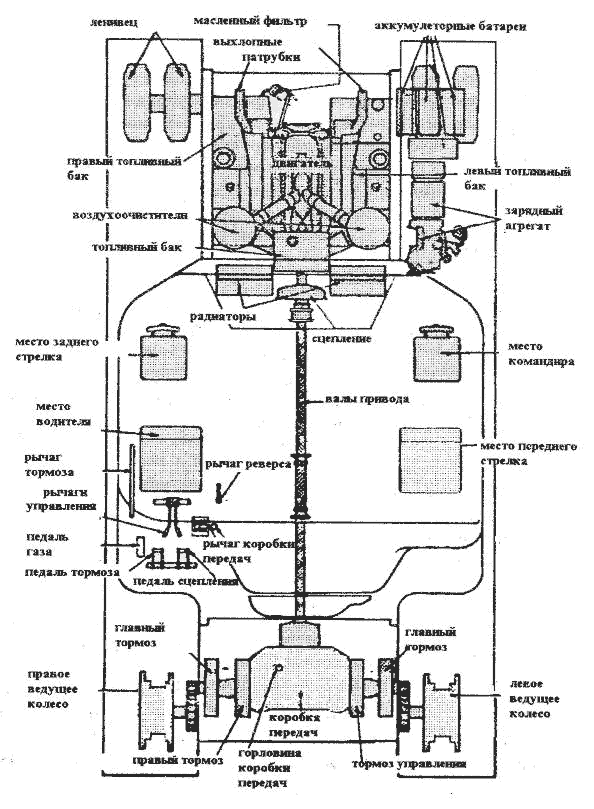
On the turret of the commander, was mounted a standard, six-barrel smoke grenade launcher, which had thus circular fire. Two more such grenade launchers were at the corners of the front sheet of the conning tower. To the left of the driver's hatch, a two-inch grenade launcher was mounted in the mobile unit. The driver’s place would have seemed familiar to anyone dealing with the Centurion, although the former was located above and to the right. However, if the person did not have special training, he would not feel very comfortable in this place - the control of the tank was shifted to the right, so that the driver had to sit at some angle to the direction of travel. In addition, if the driver drove the tank through the open hatch and the seat was therefore elevated, it was difficult to reach the pedals. When fully equipped, the N 39 / 19 radio station (on the left, between the commander and the shooter) was installed on the A38 Tortoise, providing both external and internal communications, as well as communication with an infantry, worn radio station, fortified by the tank's thinning. The commander and the driver could communicate, but only the left loader could really adjust the station.
As already noted, the A39 Tortoise was a tank and that was exactly what was listed in the documents of the Royal Armored Corps. At the same time, it could be considered a good anti-tank self-propelled gun. In this case, A39 Tortoise came under the jurisdiction of the Royal Artillery, and when in the summer of 1949 Mr. P1 was sent to fire tests, he came to Lakhill under Salisbury Planin - the heart of the "land of gunners." By that time, it was clear that the A39 Tortoise would not be accepted as a tank, and the artillerymen decided to try the tank to develop future requirements for anti-tank self-propelled guns. But there was no chance to test it. At first, the firing range officer responsible for working out the shooting parameters calculated that the firing range, even direct fire, is too long to ensure safety outside the range. Then the Military Office decided to transfer the self-propelled anti-tank artillery to the Royal Armored Corps.
As a result, A39 Tortoise was taken to Lulworth, under Bovington, to an artillery training tank school; where there was enough space for shooting (referred to as the English Channel), to ensure safety when the projectile was out of range. Tankers decided to test for the future features of separate loading and at the same time compare ways of loading the gun with those adopted in artillery. For this, the crew was staffed from both tank crews and gunners. For comparative tests in Lulworth was driven "Centurion" -III. Since the 32-pound was already tested for accuracy and armor penetration, there was still time for the sea trials, which gave the same results as the previous tests. Although the fate of the A39 Tortoise was actually decided with the end of the war, and they were not going to take it into service, two tanks were used for tests in Europe.
In April, 1948 r was decided to send A39 Tortoise Р4 and Р5 to Germany, first of all to check the possibility of transporting such large tanks within the British occupation zone. The start of work on the new series of heavy tanks FV200 was taken into account, as it was clear: where the Turtle will pass, there you can "push through" anything. It was supposed to send two samples to Germany to test them in various road conditions, and also to carry out fire tests on "live" targets at Belsen. Officially, the tests began on June 1. Their description would take too much space, but in general it can be said that the tests mainly consisted in transporting tanks across Germany.
Both A39 Tortoise tanks received personal names during the tests, but due to the poor quality of the photos, only the P5 name “Adventure” was established. It was this tank that was used for fire tests near Belsen. Shooting was carried out on the shields at a distance of 2000 m, particularly noted the good accuracy and a good impression of the new gun on the crews who are accustomed to the capricious 17-pound. Then there were firing at the decommissioned “Sherman”, whose frontal part was simply torn to shreds. Finally, the shooting was conducted on the "Panther" - judging by the photos, it was one of the cars assembled after the war under English control. Apparently, this is a model G with a frontal part of the type of tank, exhibited in Bovington. With the 1230, a projectile with a Turtle punched a Panther frontal sheet, snatched a piece of the roof over the driver’s seat and even tore off part of the gun mask that was found in 5 meters from the target. According to the test results, representatives of armored forces and artillery rated the A39 Tortoise tank very highly. However, some observers were less optimistic, and the test reports were full of such phrases: "... lack of roundabout", "... too heavy", "... too slow", "... mind-blowing transportation problems "," ... separate loading ". The fate of A39 Tortoise has been decided ...
A39 Tortoise performance characteristics:
Crew, pers. 7 (commander, gunner, machine gunner, 2 loader, driver-mechanic, assistant driver-mechanic)
Body length, mm 10060
Case width mm 3910
Height, mm 3050
Reservation
The forehead of the body, mm / deg. 228 mm
Board of the case, mm / hail. 178 mm
Enclosure roof, mm 33 mm
Front of the tower, mm / deg. 228 mm
Board turret, mm / deg. 178 mm
Roof of the tower, mm 33 mm
weaponry
Caliber and brand of gun 94-mm Ordnance QF 32 pounder
Machine guns three 7.92-mm machine gun 7.92 mm Besa MG
Engine type gasoline engine Rolls-Royce Meteor V12
Engine power, l. with. Xnumx
Highway speed, km / h 19
Rough ground speed, km / h 6
Cruising on highway, km 140
Specific power, l. s / t 7.7
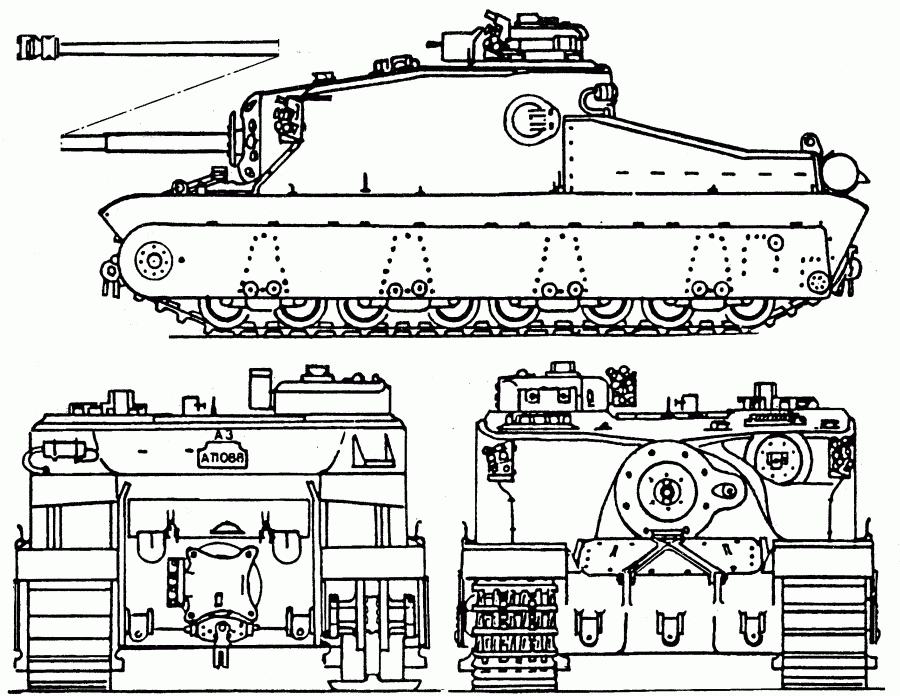
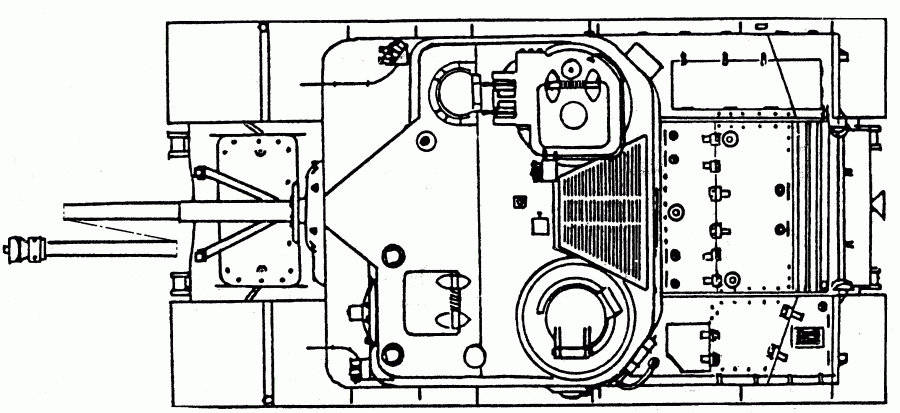
Information